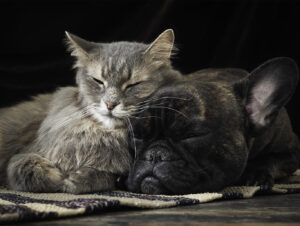Dementia In Dogs & Cats

Canine Cognitive Dysfunction (CCD - Dementia) REVISED
Canine Cognitive Dysfunction, like geriatric neuropathy, is a common and major health problem in the aging dog. Canine cognitive dysfunction (CCD), also known as canine cognitive dysfunction syndrome (CDS) or canine dementia, affects up to 60% of older dogs over 11 years of age. Fitting into this group, I see around 50% to 60% of dogs with rear leg weakness have some degree of cognitive dysfunction, and this closely parallels what is seen in people with peripheral neuropathy. Studies have further indicated that CCD is more common in smaller breed dogs because of their longer lifespan.
CCD is a behavioral syndrome with disturbances related to disorientation, sleep-wake cycle reversal, house soiling, vocalization (crying, moaning, yelping and barking) and changes in activity, either increased or decreased. Interactions with people can be affected. In some instances, the dog needs to be with one person constantly, or, in other cases, wants to have minimal contact. Aggression can also be seen, either with other pets in the household, or with people. Getting caught in a corner or under furniture often occurs and the animal can’t figure out how to return to a normal state.
It’s important to know that vocalization is seldom a sign of pain, but is often associated with anxiety and/or disorientation. The dog is a conditioned creature and their existence is based around what they have been conditioned to do and how to act. When they are unable to function in their normal routines, they can become anxious and vocalize.
Unfortunately, there are no specific treatments, although Anipryl-Selegiline has shown some promise in early stages of dementia in the dog. Hill’s has a prescription diet that their research indicates can be beneficial. Studies have also shown that supplementing with antioxidants can help to maintain routine behavioral traits. Gabapentin can be helpful in improving the night time sleep schedule and to help relieve anxiety in about 85% of dogs (See: https://www.apeacefulendingathome.com/gabapentin/ for more information on how to use this medication). Anti-anxiety medications such as Trazodone may also be used to diminish that symptom in some patients. Medical grade CBD oil (not the CBD oil from the hemp plant), seems to also diminish anxiety. However, none of these will actually treat cognitive dysfunction, but they can be valuable assets to relieve some of the worse symptoms. Assisi Animal Health has developed collars, beds and specifically placed units that use targeted pulsed electromagnetic field therapy. Through their research, they have found that this therapeutic approach can relieve both pain and anxiety in dogs (cats, too). See link below.
Because of the similarity with Alzheimer’s Disease (AD) in people, the dog is being studied extensively in hopes of developing an effective treatment, and I’m hopeful that this will lead to new veterinary diagnostic procedures/markers and medicines for dealing with this disease in dogs.
The most important aspect of CCD is to understand what is going on and how common it is. Please call to discuss. Below are several links that may help your understanding of this canine health problem.
https://vetmed.tamu.edu/news/pet-talk/cognitive-decline-in-aging-dogs/
For an extremely technical discussion and how canine dementia relates to Alzheimer’s in humans: https://www.frontiersin.org/articles/10.3389/fnins.2019.00604/full
Feline Cognitive Dysfunction (FCD)
Cats seem to have similar dysfunctions to the dog and people, but the order and frequency are different. Vocalization comes at the top of the list for FCD along with altered interaction (increased affection and/or attention) with their caretakers. Cats can also have changes in their sleep/wake cycle, activity, and increased disorientation such as wandering away or staying in areas they don’t normally inhabit. House soiling can be another sign. Having no desire to play with toys or chase a feather, can be an indicator of this problem as well. It’s important to know that these behavioral signs of cognitive dysfunction can start to be noticeable in cats over 10 years of age. If you begin to recognize any of these changes in your cat, it’s important to seek veterinary care as soon as possible. Your veterinarian can rule out other causes for what you might be seeing behaviorally. Vocalization and sleep wake disturbances can also be seen with hypertension and hyperthyroidism. House soiling, in my experience, is seen more often in the elderly cat, rather than geriatric one, but not using the litter box can also be a symptom of arthritis where the cat has difficulty getting into the box because the entrance is too high and/or the cover interferes with their ability to get into position. Scented litter, or the new “green” litters can make it uncomfortable for the cat due to the strong odor or the litter may be painful to stand on. Unfortunately, FCD is usually diagnosed when all other possible causes have been ruled out.
I have found over the years that kitty caretakers are extremely intuitive to any changes in their cat’s patterns of behavior. If you notice anything that seems to be unusual, it’s important that you not overlook your concerns. I also understand that you won’t want to make a visit to the veterinary hospital because your cat gets extremely stressed out during the ride to the hospital. Please go to the following link to read about why this is so and what you can do to minimize the stress: https://www.apeacefulendingathome.com/in-home-visits-for-cats/
As with dogs and humans, there are no treatments for cognitive dysfunction in the cat. However, there are similar medications that can be helpful in minimizing the symptoms. Gabapentin can help with anxiety and sleep/wake disturbances. Medical grade CBD oil can also be beneficial (www.vetcbd.com). Feliway and pheromone collars may help in around 50% of cats. Assisi Pet Health makes products for both cats and dogs that can have pain mitigating and calming effects (see link above)
Please call to discuss.
See link below for an involved look at this behavioral problem.
https://bvajournals.onlinelibrary.wiley.com/doi/full/10.1002/vetr.3
